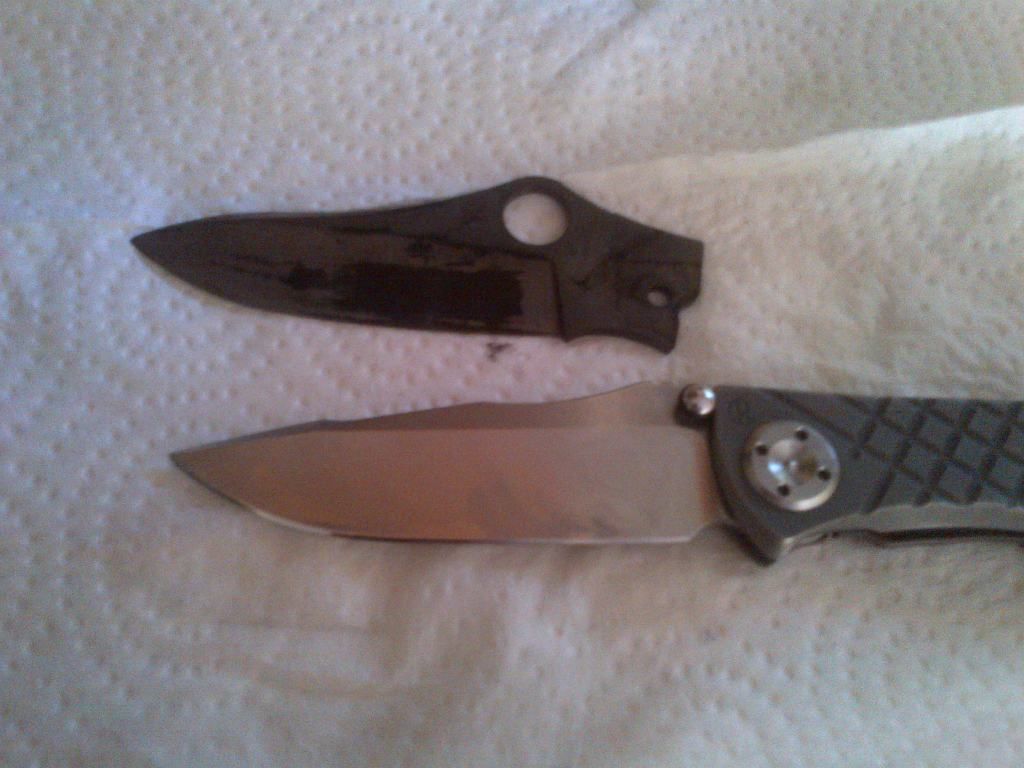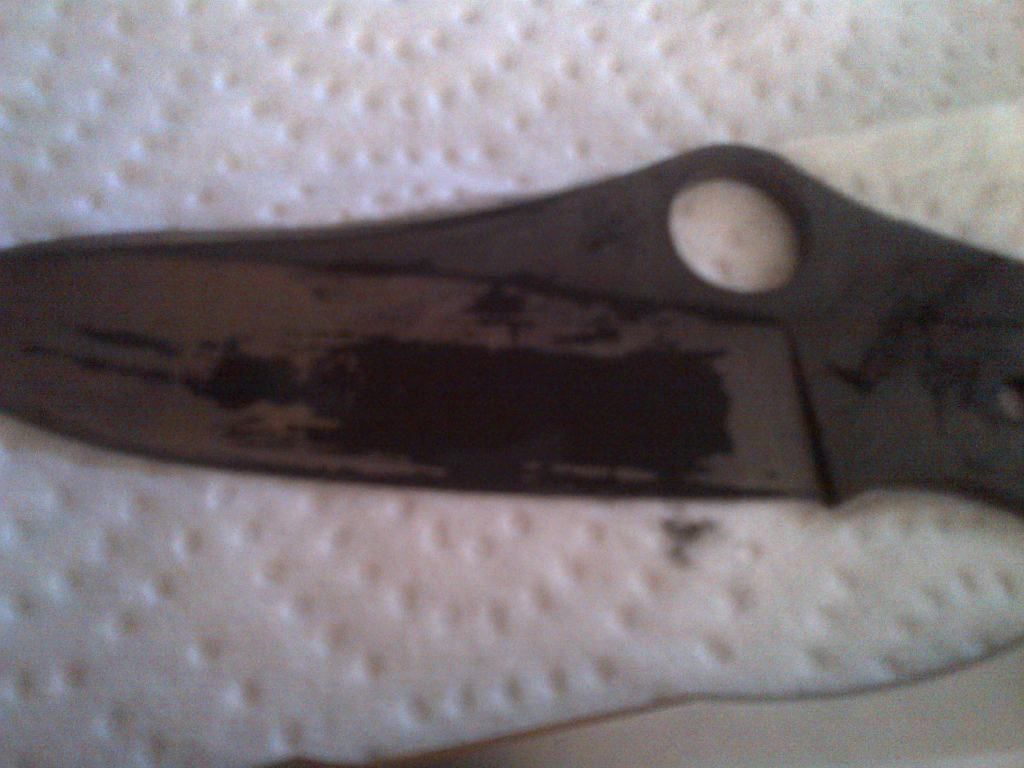Page 1 of 1
Particularly Puzzling Patina Phenomenon
Posted: Wed Jul 11, 2012 2:35 pm
by Coulro
I hope somebody can explain what is going on to me!
Here is a summary of the events of the last few days, to the best of my recollection...
Last week I got my Spyderco Gayle Bradley in the mail, I had been eagerly awaiting it and was not let down. It was smooth and well constructed like all Spyderco's I've owned but it just felt so... solid. I decided it was going into my rotation immediately and put it right into my pocket. :D
After seeing photos of other people's Gayle Bradleys with dark looking forced patinas I decided to give it a shot, I picked up a bottle of apple cider vinegar and submerged the blade in it overnight.
The next morning I jumped out of bed and ran downstairs to check on my new patina. When I pulled it out of the vinegar I wasn't sure it looked any darker at all, maybe enough time hadn't passed yet?
After about two more days the blade was a little grey but still wasn't dark like I'd seen in pictures online, other people had achieved a completely black blade, which is what I was shooting for.
At this point in time I took a quick picture on my cell phone for color reference, here it is next to a regular blade, they looked the same before the GB's vinegar bath.

Frustrated, I looked online and found someone suggesting cola instead of vinegar, and I rinsed the blade off with water and threw it into a glass of flat Pepsi.
The next morning is when something puzzling occurred, I removed the blade from the Pepsi and it looked slightly darker, but when handling it my fingernail 'scratched' the blade and left a
black mark.
It was like I was scratching silver paint off an underlying black surface. I scratched my fingernail vigorously across the entire blade to see what would come off, and the result can be seen here (with another blade for comparison):

I couldn't get any more of the 'silver' to come off so I put in back in the Pepsi bath. This morning was about 48 hours later and the blade looks the same:

Can anyone explain to me what's going on? Maybe this is a normal or uncommon but well known result? I have no experience with non-stainless blades and patina outside of seeing pictures online and the events above.
Note: when submerging the blade in vinegar the first time I applied lip balm to the pivot and edge to try and prevent patina from forming there. (Didn't seem to work so I wiped it off)
If this in unusual can someone hypothesize what happened? And propose a solution or a course of action that would yield an improvement or at least more information?
Should I use acid (FeCl or whatever?) to etch the blade? Should I try to polish it? I'm at a loss at this point...
Thanks for reading, I know it was long, but I hope it was also interesting and puzzling to someone other than me.
Sorry for the cellphone pictures, I'll get a better picture of the current condition of the blade tonight after work (I put it back in the Pepsi for now).
Posted: Wed Jul 11, 2012 3:41 pm
by dbcad
Hey Coulro, I've heard prepared mustard develops a patina pretty quicly. Over time maybe the cider vinegar would have done it although I believe some air (Oxygen) on the blade might have helped. Weak aqueous bases when exposed to air will form a patina on non stainless steel.
Pepsi and other soft drinks are a mildly acidic solution. I have no clue how it affected the M4 :o
There must be a couple of chemists around here that understand what happened.
I wish you the best with it :)
Posted: Wed Jul 11, 2012 3:56 pm
by Clip
I wouldn't use an acid such as FeCl as I've seen people get good results as you described. I'd try to polish it completely and start over, as it might've still had a surface protectant/oil from manufacturing. Also, I've heard that it takes minutes to a half hour to develop results. But, I haven't tried it or read all the threads with instructions. The only patina I've formed is on the SB Caly and A2 Little Creek and those happened **** near instantly. Also heard people suggesting to stab a potato or an apple and leave the blade in for a while.
Try starting it over and hitting it with a good cleaner first (acetone, mineral spirits, etc).
Edit: I had to read this thread after the title drew me in.
Posted: Wed Jul 11, 2012 4:12 pm
by mikerestivo
Here are big props to Coulro for use of alliteration in the title of the post. It got my attention, too.
Posted: Wed Jul 11, 2012 4:35 pm
by kbuzbee
dbcad wrote:although I believe some air (Oxygen) on the blade might have helped.
IMO, you nailed it. Soaking in vinegar is fine but you need oxygen too. Remove it, briefly scrub with a nylon sink brush and replace until you get the effect you want. M4 can sit in vinegar for a week and do little but turn light grey (which is fine, btw

)
Ken
Posted: Wed Jul 11, 2012 4:40 pm
by Fred Sanford
Did you get the knife brand new from a dealer or was it "new" from a forum or something?
I ask because one of the GB's that I had I sold. It was still new but the blade had already been rubbed down in Tuf-Glide for when I stored it. I imagine that if someone tried to put a patina on that GB when they got it that it would not work to well as Tuf-Glide rocks and keeps even M4 from rusting.
:)
Posted: Wed Jul 11, 2012 4:42 pm
by kbuzbee
Coulro wrote:I removed the blade from the Pepsi and it looked slightly darker, but when handling it my fingernail 'scratched' the blade and left a black mark. It was like I was scratching silver paint off an underlying black surface. I scratched my fingernail vigorously across the entire blade to see what would come off, and the result can be seen here (with another blade for comparison):
You weren't scratching off silver, you were spreading black oxide. It you take it so far that you're getting black oxide like that, you have to allow it to dry/harden on the blade once it's spread evenly. If you rub it right away, you can rub some of it off.
Also note, that black oxide is rough. You'll loose the smooth finish of your blade. It's a cool effect but it negatively impacts performance of the blade, somewhat.
Ken
Posted: Wed Jul 11, 2012 6:17 pm
by Coulro
First let me say that this is an amazing forum and community. I posted this same thread on that other forum (..the one concerned with
blades and
forums...) and the response here was much better.
Clip wrote:
Edit: I had to read this thread after the title drew me in.
mikerestivo wrote:Here are big props to Coulro for use of alliteration in the title of the post. It got my attention, too.
Glad it worked :D
kbuzbee wrote:IMO, you nailed it. Soaking in vinegar is fine but you need oxygen too. Remove it, briefly scrub with a nylon sink brush and replace until you get the effect you want. M4 can sit in vinegar for a week and do little but turn light grey (which is fine, btw

)
Ken
kbuzbee wrote:You weren't scratching off silver, you were spreading black oxide. It you take it so far that you're getting black oxide like that, you have to allow it to dry/harden on the blade once it's spread evenly. If you rub it right away, you can rub some of it off.
Also note, that black oxide is rough. You'll loose the smooth finish of your blade. It's a cool effect but it negatively impacts performance of the blade, somewhat.
Ken
You sir seem to know a lot more than I do!
What would be your suggestion to remove the black oxide? I just dried it off and it does seem rough, not what I wanted at all.
Maybe I'll try steel wool or high grit sandpaper?
I'm going to try it again, how should I proceed in order to attain a dark uniform finish and avoid this terrible black oxide nonsense?
Thanks so much for your help, it's been driving me CRAZY trying to figure out what happened. :)
Posted: Wed Jul 11, 2012 6:25 pm
by kbuzbee
Coulro wrote:
What would be your suggestion to remove the black oxide? I just dried it off and it does seem rough, not what I wanted at all.
Maybe I'll try steel wool or high grit sandpaper?
I'm going to try it again, how should I proceed in order to attain a dark uniform finish and avoid this terrible black oxide nonsense?
Thanks so much for your help, it's been driving me CRAZY trying to figure out what happened. :)
Sandpaper would be be my choice, but it takes some work.
Don't misunderstand, this black oxide IS your patina, just a bit thicker than most people prefer it, at the levels I was talking about. If you were to just soak it again, say a day, then give it a light brush with a nylon brush/scotch brite.. whatever, if it's all black at that point, hang it by it's pivot hole to dry (like with a bent paper clip)
And it won't likely be quite as uniform as it is in your mind. It's a natural process. You're just hurrying it along.
Good luck,
Ken
Posted: Wed Jul 11, 2012 7:06 pm
by Coulro
kbuzbee wrote:Sandpaper would be be my choice, but it takes some work.
Don't misunderstand, this black oxide IS your patina, just a bit thicker than most people prefer it, at the levels I was talking about. If you were to just soak it again, say a day, then give it a light brush with a nylon brush/scotch brite.. whatever, if it's all black at that point, hang it by it's pivot hole to dry (like with a bent paper clip)
And it won't likely be quite as uniform as it is in your mind. It's a natural process. You're just hurrying it along.
Good luck,
Ken
Appreciate the advice, I'll try again and report back.
Posted: Thu Jul 12, 2012 1:52 am
by Popsickle
i did vinegar for 30 minutes on my custom Strider SnG DDC M4.... in 10 minutes out 1 for a couple dips. then i just cut fruit and the patina got darker. something i did when spotting would show up is use a powder abrasive like barkeeps friend to clean it and it would darken even more/
Posted: Thu Jul 12, 2012 2:18 am
by Phrenik
On a similar note, for you guys who have done this trick, have you noticed any .... raw steel smell? kind of like that really bitter/irony/metalic smell you can also get from the chains on swings etc? Thats what mine smells like and its been a bit off putting to use for food, so I had just been using a sog flash 2 for fruits instead of the gb. I had used my dlc para 2 but the dlc started to fade away after using it on fruits so i stopped. Anywho is the smell normal? or is there another mystery step in helping the smell go away?
Posted: Fri Jul 13, 2012 4:58 am
by peacekeeper
Hi
Try pema blue,normally it is for blueing guns but it will work fine,it works for me!
Go ytube-blueing my knife blade.
If you use vinegar you have to boil the vinegar first then put the blade in,after view minutes it startet kind a boil reaction,again ytube-etching my blade with vinegar.
My opinion,stick with perma blue,it is easy and much more beautyful,all others are a kind of experiments,mark my words!
Posted: Fri Jul 13, 2012 2:12 pm
by Coulro
Havent had a chance to attack my knife with sandpaper yet, crazy busy at work.
Phrenik wrote:On a similar note, for you guys who have done this trick, have you noticed any .... raw steel smell? kind of like that really bitter/irony/metalic smell you can also get from the chains on swings etc? Thats what mine smells like and its been a bit off putting to use for food, so I had just been using a sog flash 2 for fruits instead of the gb. I had used my dlc para 2 but the dlc started to fade away after using it on fruits so i stopped. Anywho is the smell normal? or is there another mystery step in helping the smell go away?
DLC
definitely should not be removed by cutting fruit. It's probably just residue dried onto the blade and making it look faded, DLC is one of, if not, the toughest blade coatings available.
Also my monster of a failed patina smells weird too, kinda like vomit and pennies.

Posted: Fri Jul 13, 2012 5:55 pm
by Ed Schempp
My guess at the uneven result would be residue on the blade from fingers or lubricating oil or material that you have cut. The blade has to be completely clean before etching whatever method that you use. M4 tends to pit before rusting and can be a problem in the future with maintenance of the blade. Carbon steel patinas nicely when cutting meat, I believe this is a Nitric acid reaction.
I use fingernail polish as a resist for etching, many things will work, but some tend to be messy and can easily transfer about the blade with much handling. A marks-a-lot permanent marker will do for short duration.
The blade with patina with use, particularly in the kitchen. That will give you a record of knife using events, you will own each stain, and they will come and go...Take Care...Ed
Posted: Sun Jul 15, 2012 6:58 pm
by tikkidaddy
I always found a spanish (yellow) onion patinas carbon steels quite well w/ normal use. Brownells Oxpho-Blue rox too!!---mb





